Affiliate links on Android Authority may earn us a commission. Learn more.
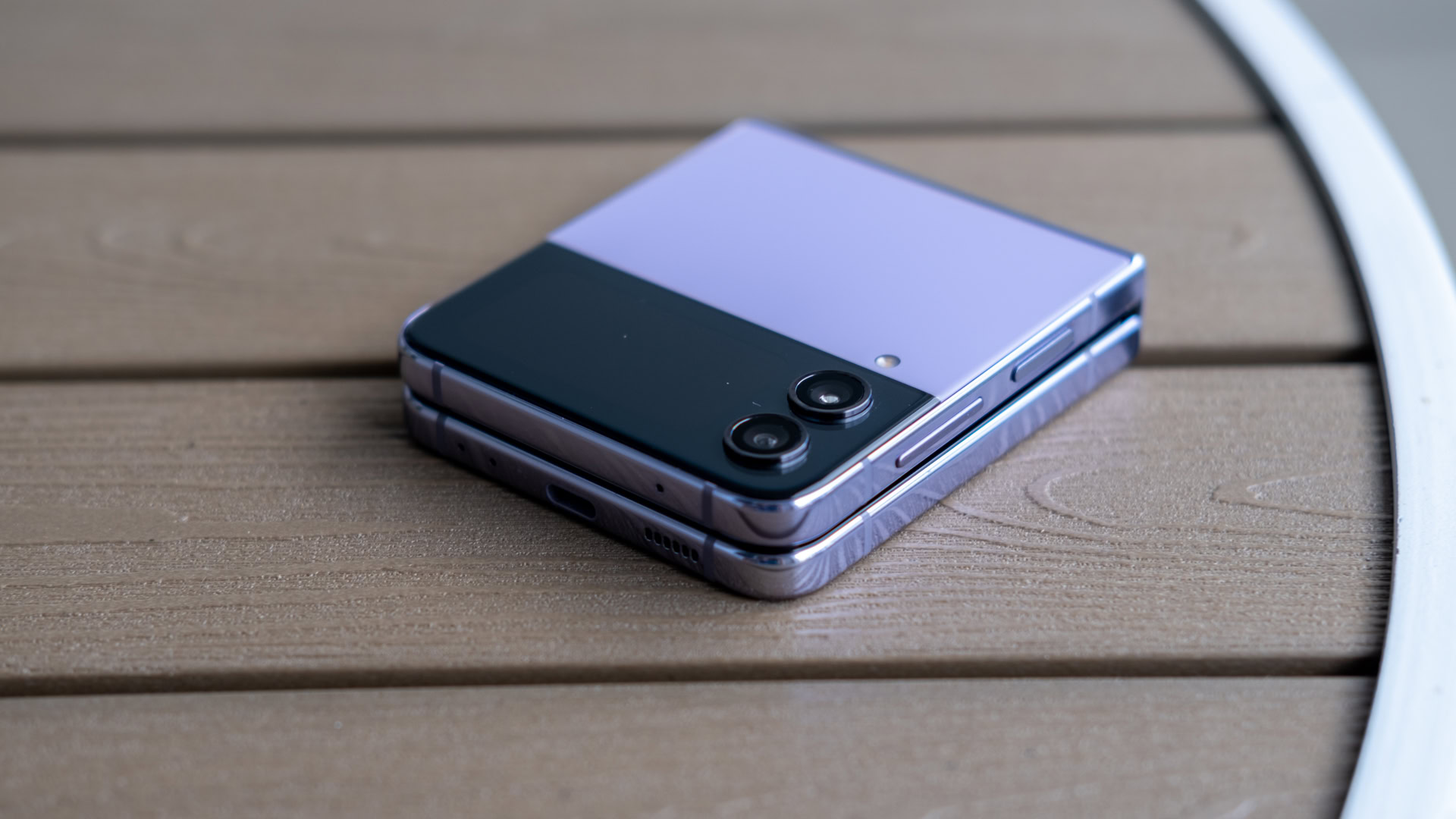


Samsung Galaxy Z Flip 4
What we like
What we don't like
Our scores

Samsung Galaxy Z Flip 4
There are plenty of old sayings about things changing, things not changing, things changing by not changing — you get the picture. It’s tough to tell which applies to Samsung’s Galaxy Z Flip 4 because it has both changed and stayed almost entirely the same. The tweaks are minor yet carefully planned, which Samsung hopes will widen its already monumental lead in the foldable phone market. Are small steps enough to make a big impact? Find out in our Samsung Galaxy Z Flip 4 review.
Update, August 2023: We’ve added details relating to the Samsung Galaxy Z Flip 5 and recent software updates.
What you need to know about the Samsung Galaxy Z Flip 4
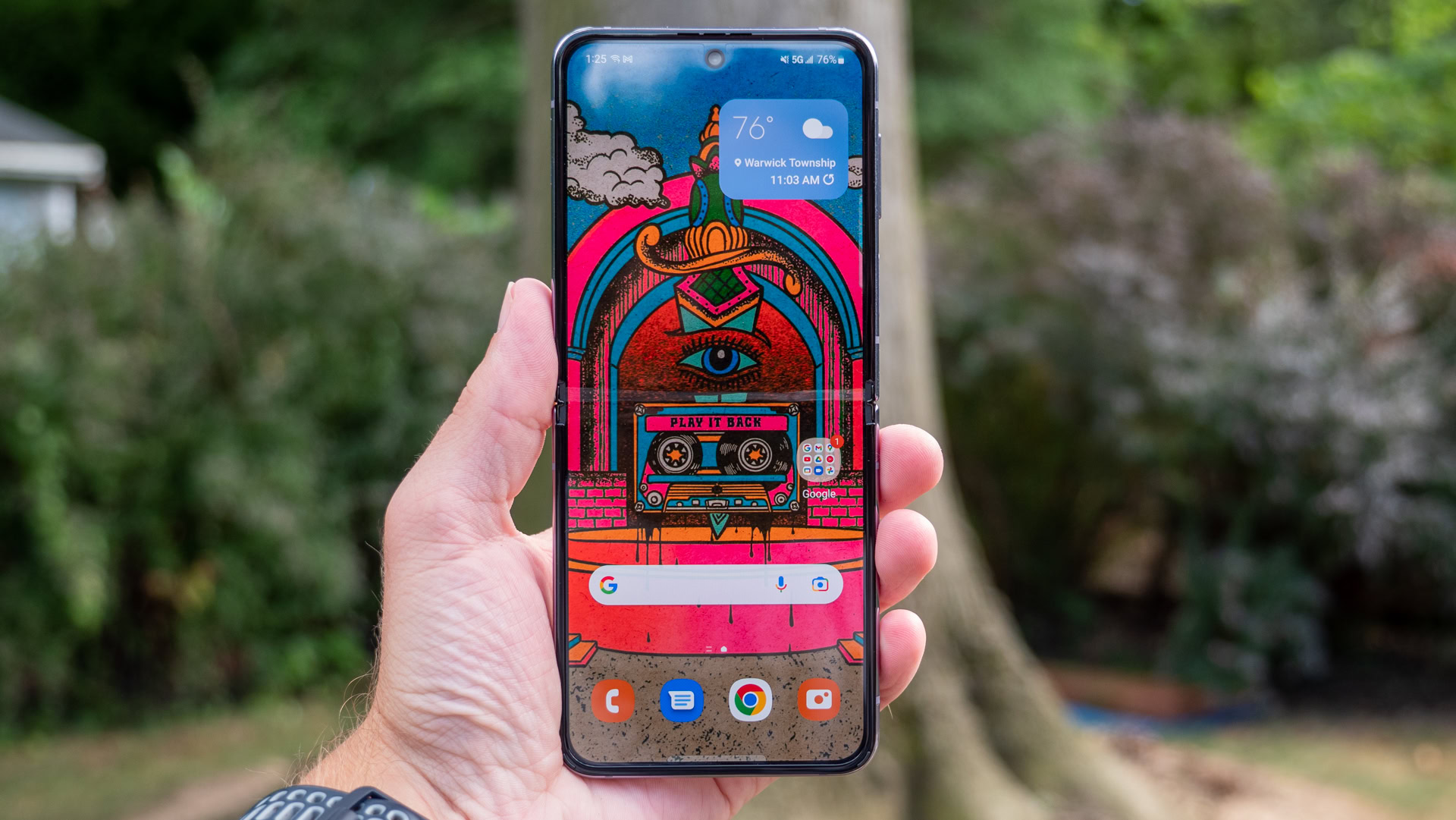
- Samsung Galaxy Z Flip 4 (8GB/128GB): $999 / £999 / €1,099
- Samsung Galaxy Z Flip 4 (8GB/256GB): $1,059 / £1,059 / €1,159
- Samsung Galaxy Z Flip 4 (8GB/512GB): $1,179 / £1,199 / €1,279
Samsung launched its Galaxy Z Flip 4 in August 2022 as a successor to its popular Galaxy Z Flip 3. It steps in almost all of its predecessor’s footprints, almost to the point that you can’t tell them apart. However, Samsung made a few clever internal changes that push its latest clamshell further than before. If you want to push even further than that, Samsung has also released its Galaxy Z Flip 5, which brings a brand-new Flex Window and updated Snapdragon 8 Gen 2 for Galaxy processor.
On the outside, you’ll find that Samsung’s 1.9-inch Super AMOLED “Cover Screen” — the tiny one next to the camera — is now made of Gorilla Glass Victus Plus. It’s slightly more durable than the previous model, though otherwise unchanged in pixel density. The internal folding display is also on par with its predecessor; it still measures in at 6.7-inches with a Full HD+ resolution. It packs a smooth 120Hz variable refresh rate and up to 1,200 nits of peak brightness. The rest of the package is equally as refined, with Armor Aluminum for the frame and Samsung’s improved Ultra Thin Glass (UTG) covering the screen.
Once you dive below the tough IPX8-rated outer shell (almost sounds like a clam, doesn’t it?), you’ll find a host of updates from the Galaxy Z Flip 3. Samsung brought Qualcomm’s latest Snapdragon 8 Plus Gen 1 chipset into the mix, which boosts both power and battery efficiency over the regular Snapdragon 8 Gen 1 we saw in the Galaxy S22 series. It’s paired with 8GB of RAM across all three configurations, and you can opt for up to 512GB of storage. The extra storage is worth a look if you’re going to be filling it with larger files, too, as there’s no microSD slot.
The Galaxy Z Flip 4's familiar aluminum frame hides a host of performance upgrades under a glossy coat of paint.
Perhaps most important is the Galaxy Z Flip 4’s larger battery — a critical weak point for the last-generation foldable. It’s grown from 3,300mAh to 3,700mAh, right in line with the vanilla Galaxy S22 and Galaxy S23. The wired charging got a nice boost, too, jumping from 15W to 25W. Wireless charging is an option, still at 10W, as is reverse wireless charging at 4.5W.
As seems to be the tradition now, there’s less in the Galaxy Z Flip 4 box than ever. While the earliest foldables came with some packaging pomp and circumstance, the 2022 iterations offer no more than basic paperwork, a USB-C cable, and a SIM ejector tool. It’s not a surprise, though it does mean you’ll have to invest in a new charger if you don’t already have a compatible one.
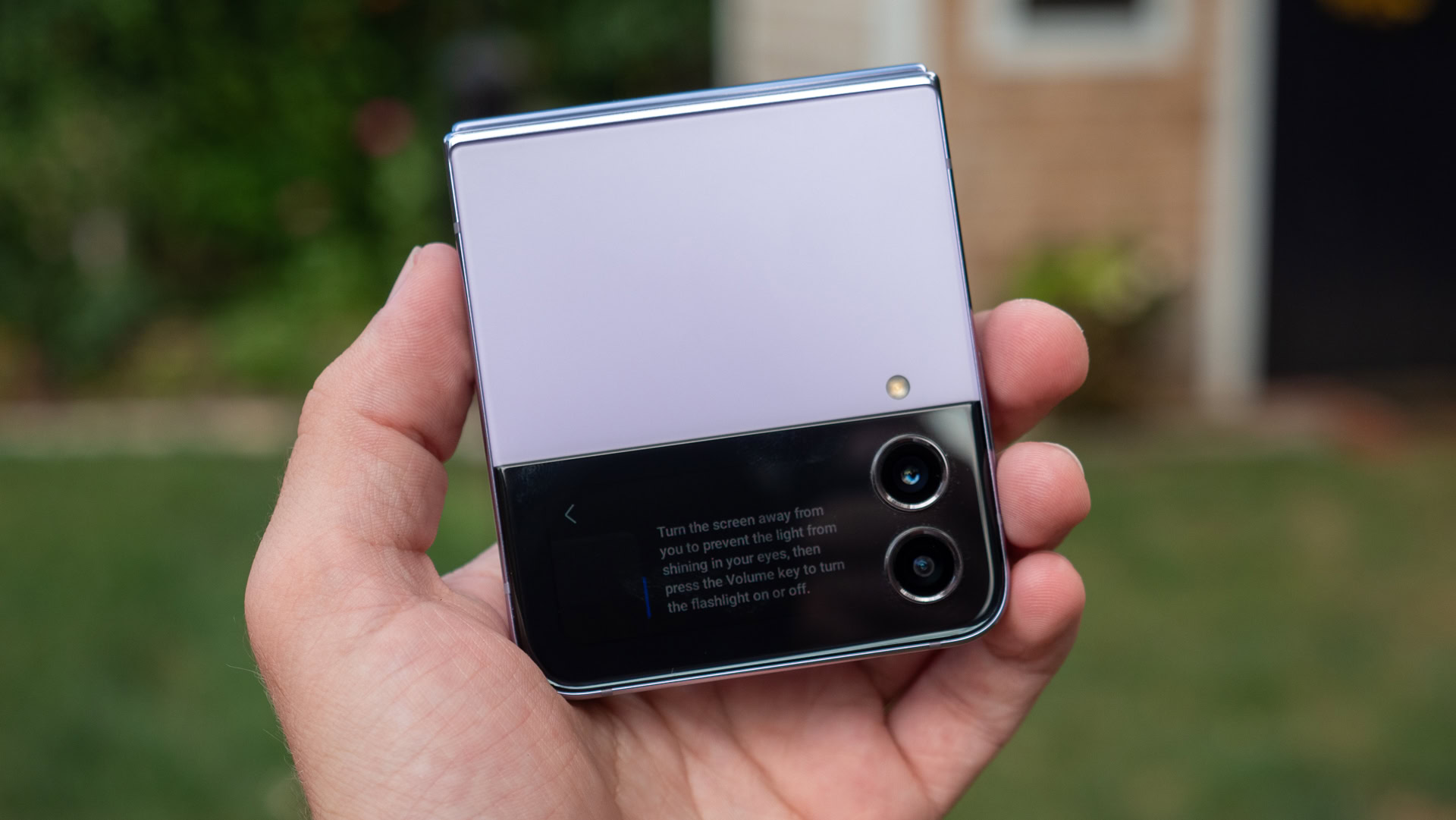
The Galaxy Z Flip 4 sits in a rarified spot when it comes to competition — it’s already the king. Samsung holds a dominant 88% market share of all foldables, and the Galaxy Z Flip 3 was the sales leader. The previous-generation foldable is still the top competition, especially now that you can get it heavily discounted. Motorola’s 2022 Razr barely made it outside of China, and HUAWEI’s P50 Pocket has the usual slate of headaches you’d expect from a phone without Google’s support. Whether the dominance continues remains to be seen, with Motorola introducing a much-improved Razr Plus in early 2023. For now, though, the Galaxy Z Flip 4 is better stacked against devices in the same price bracket — around the $1,000 mark — like Samsung’s own Galaxy S23 Plus and the upgraded iPhone 14 Pro.
The Galaxy Z Flip 4 arrived for sale on August 26 at Samsung, Amazon, Best Buy, and more in the US, as well as most major markets worldwide. It comes in Bora Purple (pictured in this review), Graphite, Pink Gold, and Blue colorways. There is also a Bespoke Edition which allows you to customize the frame and rear for up to 75 different combinations, though it’ll set you back at least another $100 over the regular version.
Has the Samsung Galaxy Z Flip 4 design changed at all?
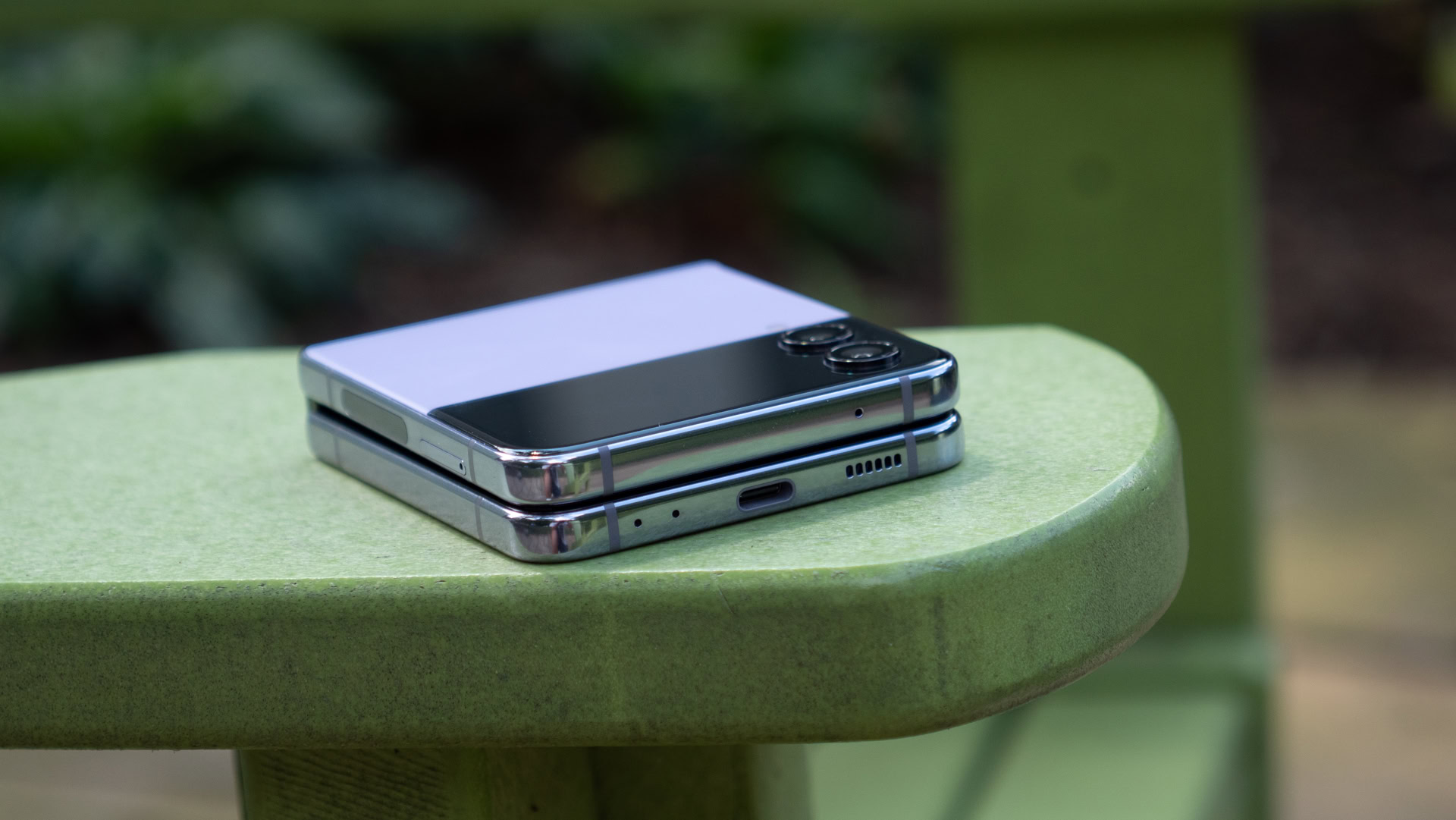
Al Pacino talked about a game of inches during his locker room speech in Any Given Sunday; waxing poetic about how small changes and events add up to create the bigger picture. Samsung apparently took that message and took it a step further. Instead of a game of inches, the Galaxy Z Flip 4’s updated design is a game of millimeters.
Honestly, you could set the Galaxy Z Flip 4 right next to the previous Galaxy Z Flip 3 (which we did) and have almost no way of knowing them apart. Unless you’re whipping out a microscope to look for the 0.4mm of height or 0.3mm of width that Samsung shaved off, you won’t notice it. However, that trim ticks the screen-to-body ratio slightly higher and results in a device that’s as comfortable to hold as any traditional flagship.
All the buttons and ports are right where you’d expect them to be if you’ve used any recent Samsung Galaxy phone. The capacitive fingerprint reader and volume rocker are right at home along the right edge, while the SIM slot is nestled in the top left corner. Samsung tucked its USB-C port and one of its stereo speakers along the bottom edge, with the earpiece as the second speaker to form stereo sound.
The Galaxy Z Flip 4 refines an already excellent design that's as good in the hand as it is to look at.
Another benefit of the familiar design is that Samsung’s durable Gorilla Glass Victus and Armor Aluminum combo makes a return. This year, however, the glass is upgraded to Gorilla Glass Victus Plus on the external display and the colorful rear glass panels. The Armor Aluminum frame also has a glossy finish compared to the previous model’s satin sheen. Samsung’s Ultra Thin Glass once again covers the inner display, though the South Korean giant says it’s been toughened up compared to the Galaxy Z Flip 3’s protective layer, and has been internally tested for up to 200,000 folds. The company also claims it has improved the adhesive used to apply the all-important screen protector. We couldn’t test this without potentially leaving the device vulnerable to permanent damage. On that note, if you do pick up a Galaxy Z Flip 4, do not remove the screen protector! It’s an essential part of the display.
Despite Samsung’s healthy trim around the edges, the Galaxy Z Flip 4’s internal display remains at 6.7 inches along the diagonal. It’s still an excellent 120Hz variable panel, with good color recreation and a peak brightness of up to 1,200 nits. During my testing, I had no issues with it being too dim, and the tall, thin shape remains easy to stretch a thumb across. You could, in theory, use the Galaxy Z Flip 4 with one hand from the time you open it to the time you close it, but I found it to be a challenge. The hinge is a bit too tight to press with a thumb, but it does a good job of keeping the display in place.
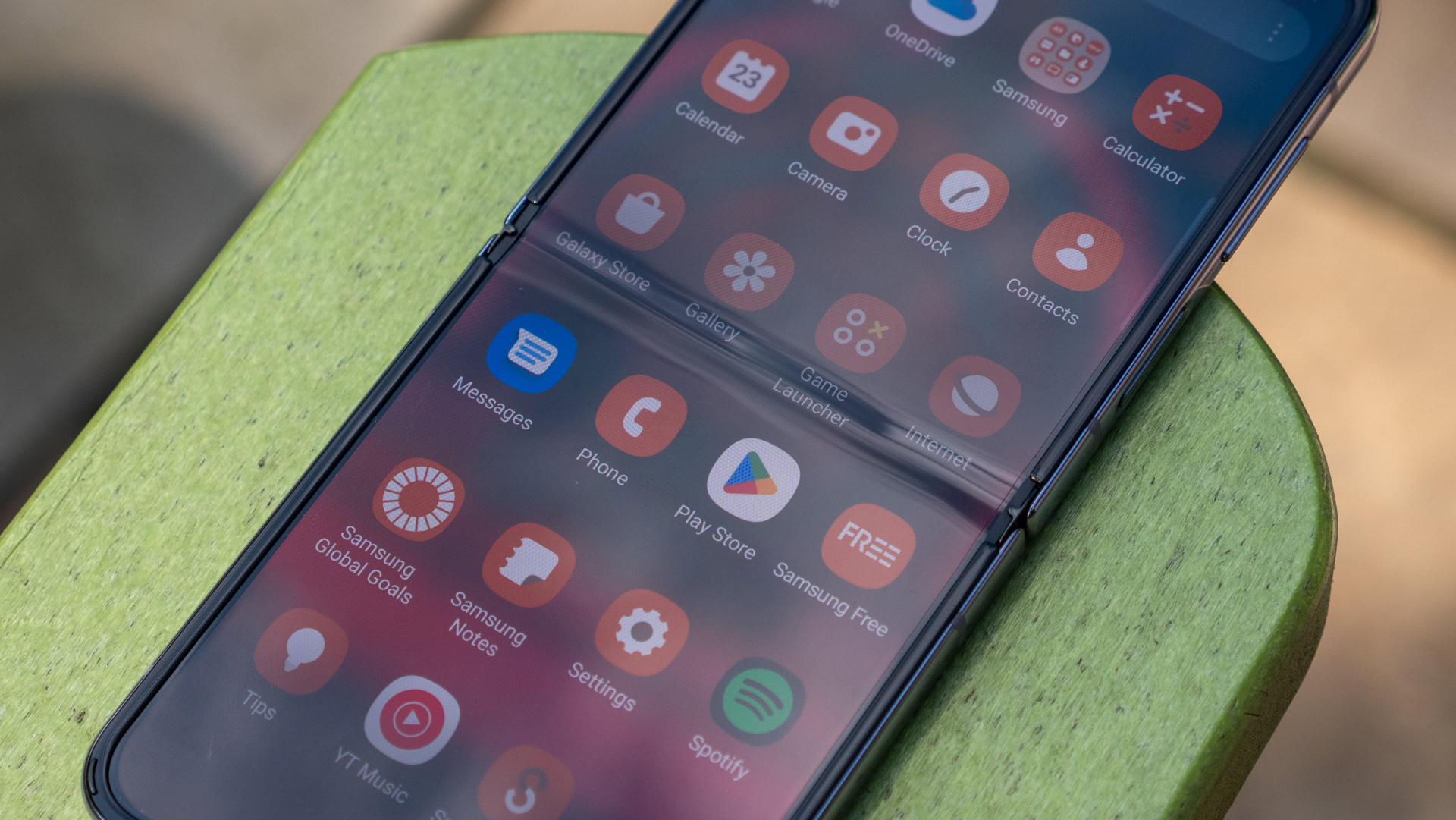
That said, sometimes change can be a good thing. Unfortunately, Samsung’s lack of change means that the display crease is still plainly visible and is no smaller than in previous generations. Your eye can learn to ignore it, and your thumb might not graze over it very often, but it’s still there, and any casual observer is bound to ask you about it.
Also essentially unchanged, other than the Gorilla Glass Victus Plus upgrade, is the Cover Screen. It remains at 1.9 inches with a resolution of 260 x 512, and that’s about it. There are a few new software wrinkles, but we’ll come back to them in a bit. If you really want a new software experience on your Galaxy Z Flip cover screen, you’ll have to pick up the Galaxy Z Flip 5, which offers what Samsung calls the Flex Window — a 3.4-inch, folder-shaped cover screen with support for full-featured apps through Good Lock.
How is the battery life? And the charging?
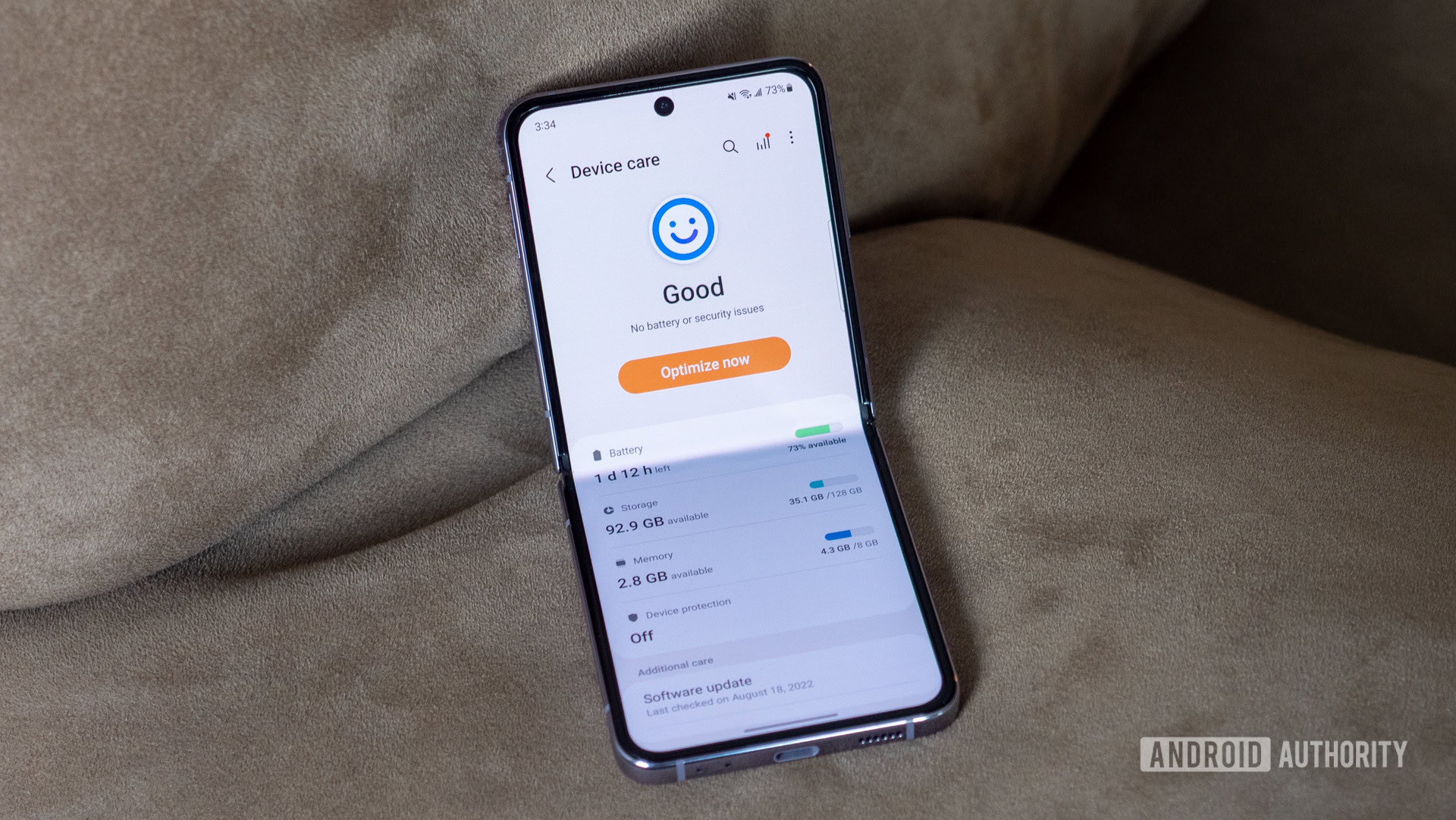
For all that the Samsung Galaxy Z Flip 3 got right, its battery life remained a glaring issue. The tiny 3,300mAh cell and 15W wired charging were unchanged from the first- and second-generation Galaxy Flip phones, and they needed a careful push to make it through the day. Sure, the relative lack of punch offered a convenient excuse to rely on the Cover Screen, but when you buy a device for its folding display, you’re going to want to use it.
Thankfully, the battery and charging receive one of the biggest boosts of the entire operation. The Galaxy Z Flip 4 now packs a 3,700mAh battery with 25W wired charging — the same as the vanilla Galaxy S22. Of course, like other Samsung flagships, that also means you’ll need a USB Power Delivery PPS charger to reach top speeds, and you won’t find one bundled in the box. Check out our charger guide for the best options if you need to pick up a compatible adapter.
Qualcomm’s fuel-efficient Snapdragon 8 Plus Gen 1 lends a hand to the improved battery life, perhaps as much as the larger battery itself. Regardless of which has had the biggest impact, the key takeaway is that the Galaxy Z Flip 4’s battery no longer feels like a liability. You’re not likely to blaze past a full day of usage, but you shouldn’t be sweating your remaining charge until well after dinner time.
I had no problems on an average day of web browsing, social media, and moderate streaming, but it still may help to memorize where the Power Saving feature is in the Quick Settings. On one of my heavier days — heading to New York for a briefing event — I got to experience how the Galaxy Z Flip 4 handles a heavy load. The phone shone as my Amtrak ticket, my trusty navigator to the venue, and even my ticket into Yankee Stadium. However, I turned Power Saving on by the time I reached the game, and by the time “New York, New York” played, I was sitting at about 10% battery left.
The larger battery and faster charging mean the Galaxy Z Flip 4's power no longer feels like a liability for everyday use.
Overall, I averaged between four and five hours of screen-on time throughout my time with the Galaxy Z Flip 4. That’s still not on par with traditional flagships, but the external display remains an excellent way to check basic notifications. That way you only need to respond to those that matter when unfolded. It all just requires a bit of reconditioning from how you’d use a regular “slab” smartphone.
Once you empty the still relatively small cell, the 25W wired charging should have you back on the go in about 75 minutes. I found that it took slightly longer on some days, though rarely much more than 80 minutes. Samsung’s wireless charging will take a bit longer, somewhere around 90-100 minutes, but it’s good enough if you’re charging while you work.
How is the software?
If this is your first time with a foldable phone — and it probably will be for many — it’s good to know what software wrinkles you’re getting into. While the overall experience when unfolded was very much like traditional Android 12 at launch, the return of Samsung’s “Flex mode” is important for all other positions. Although Samsung’s Flex mode has been around since the early days of the Flip, the Flex mode panel remains a special Labs feature, which means it won’t always work correctly, nor will it work with most third-party apps.
Once you open the Flex mode panel menu, you’ll see a long list of every app on your phone and how it interacts with the modified controls. Some, like the native Calendar and Camera apps, offer unique layouts with controls below the fold and data above it. Others, like Chrome, open a menu along the bottom panel where you can control brightness, take screenshots, and even open a trackpad. It’s fun to try the trackpad once or twice to feel like you have the world’s smallest laptop, but it quickly becomes less practical than if you were to simply use the phone like normal.
I did, however, use the Flex mode panel with the Galaxy Z Flip 4’s Camera app for a feature that has its own name — “FlexCam.” Although the name is new for the Galaxy Z Flip 4, the feature is familiar. Essentially, it allows you to fold your phone and sit it on a flat surface to take group selfies by waving your hand. It feels slightly ridiculous to hold the phone like a classic camcorder, yet it makes the shutter button easy to reach without risking shaky hands. I felt like I could keep a steady grip and reach various settings with my thumb instead of stretching to the top of the display.
Samsung has also found new ways to use the Cover Screen, especially the camera, which we’ll come back to in the next section. You can now toggle more Quick Settings, including Airplane Mode, brightness, and the phone’s flashlight, which comes with a helpful reminder to point it away from your face. The Galaxy Z Flip 4 includes new opportunities to interact with your notifications, and you can respond to certain messages without ever opening your phone. Unfortunately, the responses are limited to certain apps, and you have to choose from a curated list of messages with no option to type your own.
Flex Mode is still far from the finished article, but the retooled Cover Screen feature offers plenty of unique use cases.
Beyond the new wrinkles, One UI remains one of the best Android skins. It embraces a few key tenets of Material You, most noticeably the wallpaper-based themes. You can set everything from app icons to toggle switches to coordinate with your wallpaper, though the app icon support is limited to first-party creations.
This also feels like an appropriate place to mention Samsung’s update commitment; it’s still excellent — the best in the business, in fact. The Galaxy Z Flip 4 (and its larger Galaxy Z Fold 4 sibling) will receive four years of Android version updates and five years of security patches. That should see it through until Android 16, with further security coverage into 2027.
So far, our review unit has received up to the June 1, 2023 security patch and the Android 13 update with Samsung’s One UI 5.1 skin on top. If you want to read more about the recent software improvements, check out our six-month revisit of the Galaxy Z Flip 4.
Are the dual cameras good enough?
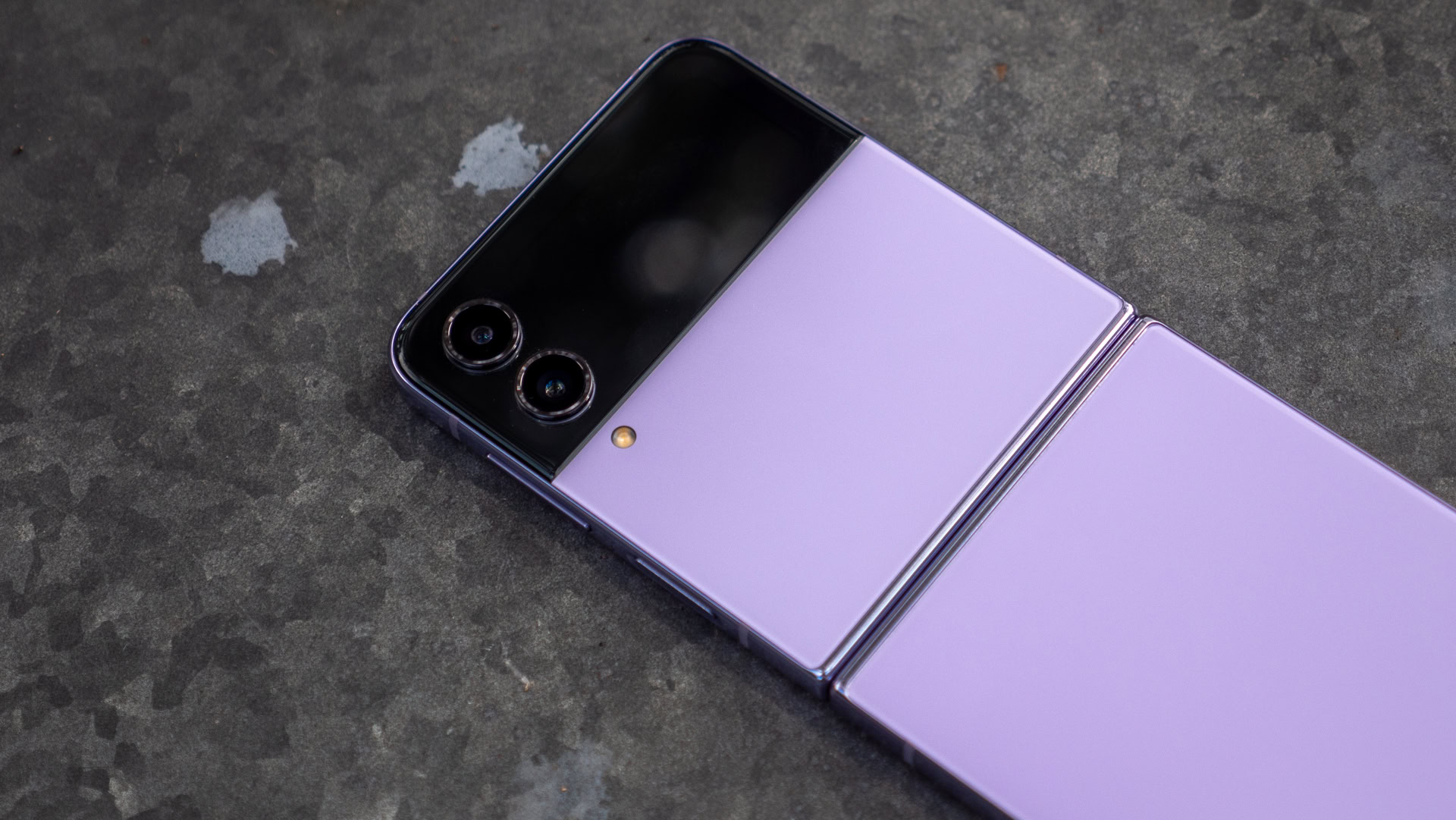
In yet another case of the Galaxy Z Flip 4 following its predecessor, the overall camera setup hasn’t changed much. Two sensors are the same — the 10MP selfie shooter and the rear 12MP ultrawide. However, the primary camera got a slight bump in pixel size, rising from 1.4μm to 1.8μm, an increase of about 65%. It’s still a 12MP sensor, but the larger pixels improve the camera’s overall light sensitivity. This results in better low-light performance, especially when compared directly against the Galaxy Z Flip 3.
Samsung has also talked up improvements to its AI processing and “Stereo Depth” mapping for greater detail in shots. Do these minor tweaks make a difference? Not so much that it’ll challenge the very best camera phones, but certainly enough to be a reliable shooter in most conditions.
Both rear cameras also now stick out slightly further than before. The glossy metallic rings around the wide and ultrawide lenses catch the eye, while the punch hole selfie camera is hoping you can ignore its thin black border. One thing you might not be able to forgive is Samsung’s love of saturation. Like the amplifier in This Is Spinal Tap, it goes to 11.
I relied on the Galaxy Z Flip 4’s primary camera for the majority of my shooting, and it delivers great results. Details are typically excellent, as are highlights and shadows. Color recreation is punchy, to say the least, with certain shades appearing far bolder than in actuality. It’s especially noticeable with green hues, especially plants like those behind the small pile of stones pictured in the bottom gallery below. The miniature golf sign is highly saturated as well compared to reality.
Despite my qualms with color, the details are well preserved. Whether the subject was close, like the pink and green plant, or far, like the New York City street, there’s little loss of detail or discoloration. Even the image of the clock in Moynihan Train Hall shows good detail through the curved glass panels and up to the buildings beyond.
As mentioned, Samsung didn’t offer changes to its ultrawide camera compared to the Galaxy Z Flip 3. It still provides a focal length of 0.5x, which lets you squeeze in more of a scene over the primary shooter. As you can see in the samples below, the latter cuts off just past the clock, while the Galaxy Z Flip 4’s ultrawide captures the candy shop to the right and a view down the boardwalk to the left. The distortion isn’t too bad in this case, though the difference in color between the two shots is noticeable. Everything is bolder in the ultrawide image, including the wood boardwalk, the word “pizza,” and even the sky.
The comparison of Yankee Stadium tells a similar story, albeit with a bit more distortion. You can easily see the difference in color recreation, though the straight rows of seats feel stretched in the foreground. In the section below where I discuss zoom, the Chevrolet Suburban in the foreground displays a similar degree of distortion.
Given that it’s only equipped with two lenses, it’s fair not to expect the Galaxy Z Flip 4 to be a zoom monster. The camera app only defaults to two profiles as quick selections — standard and ultrawide. You can digitally zoom up to 10x with crops of the main sensor, but your overall results will vary greatly. I captured decent enough details on the wall sculpture up to about 4x zoom, but the neon lights started to bleed almost immediately in shots of the Ferris wheel. There’s also no detail in the night sky as the bright boardwalk blows out pretty much everything else. Overall, given good lighting, you should be able to use the standard, and up to 4x zoom capabilities in a pinch, though I’d hesitate to go beyond.
Portrait mode, no matter the subject, is excellent as well. The Galaxy Z Flip 4 had little trouble identifying edges, even against similarly colored backgrounds, even if it wasn’t perfect. The sundial pictured below does lose a small amount of its tip, though the pedestal and the dial face are both clear. Samsung’s portrait effect isn’t as pronounced on the half-full glass to the right, though it feels like natural bokeh rather than an over-processed mess.
Samsung’s Night Mode support on the Galaxy Z Flip 4 is also impressive. All three of my sample images were taken in vastly different lighting conditions, yet each maintains a solid level of clarity. The figurine to the left was taken in the lowest light, where my naked eye couldn’t clearly replicate the colors. However, the Galaxy Z Flip 4’s new, larger sensor created a much brighter image, even if Vault Boy’s blue suit is slightly off. The gnome lamp in the middle was the only light source in that room at the time, and it manages to balance the exposure fairly well (even if it was a creepy decoration).
Samsung’s 10MP punch hole selfie camera is like its comfort food. It’s tested and reliable, even if it’s not the newest or most powerful option. As a result, the selfies from the Galaxy Z Flip 4 are almost identical to those from the Galaxy S22 series or even the Galaxy S21 series before it. They’re not bad, at least as far as the subject is concerned, though some leaves behind me tended to blend in the standard shot below. The selfie camera’s edge detection is excellent, having only missed a few of my hairs along the way. I will say that the color recreation seems to come out slightly better on the portrait mode image, especially on my face.
As promised, it’s time to discuss external cameras as selfie lenses. This is one of the larger improvements regarding the Galaxy Z Flip 4’s Cover Screen, as now you can control the Quick Shot camera mode through a series of taps and swipes instead of just hitting the shutter. It’s easy to activate the mode with a double-press of the home button, and then you can swipe left or right to bounce between photo, video, and portrait modes. Swiping up or down toggles the primary and ultrawide cameras, while a double-tap on the display adjusts the aspect ratio — another welcome change as the Galaxy Z Flip 3 could only shoot in 1:1 to match the previews.
The controls can be tricky to master at first (keeping your thumb out of ultrawide shots is a bit of a pain), but the results speak for themselves. The details and the portrait mode edge detection are far better on the superior main rear camera, and the ultrawide provides ample room to fit in friends or unique backgrounds.
Going along with the talk of external cameras as selfie shooters, this is where “FlexCam” is at its best. As long as you can find the right surface to balance your phone on, waving to the camera couldn’t be easier. I can appreciate not having to set a timer and go on a mad dash to get into position within a few seconds. You can also start recording videos in Quick Shot mode and transition to Flex mode without ever stopping the recording.
Unfortunately, one victim of Samsung’s continued use of a dual-camera setup on the Galaxy Z Flip 4 is its Expert RAW app. You won’t be able to tap into professional-level controls on the small clamshell anytime soon, as it lacks the requisite 3x telephoto shooter. Perhaps we’ll see the camera array change down the line to add a dedicated zoom lens, but not this time.
As for video, the Galaxy Z Flip 4 is capable of up to 4K at up to 60fps from the rear cameras. It also covers 1080p video at up to 240fps, as well as 720p at up to 960fps if you need a little slow-mo in your life. Not much has changed here in terms of quality, it’s perfectly fine, with decent color and detail capture. The Galaxy Z Flip 4’s unique form factor does still make it perfect for holding the phone like a classic camcorder.
The samples above are only some of the shots I took during my time with the Galaxy Z Flip 4. You can check out these and the rest in full resolution in this Google Drive folder.
How powerful is the Samsung Galaxy Z Flip 4?
The Samsung Galaxy Z Flip 4 is a classic case of “small but mighty.” Its flagship Snapdragon 8 Plus Gen 1 processor leaves little doubt about its performance, even if the pocket-friendly form factor feels more tuned to play than to punch. It had no trouble keeping up with my day-to-day tasks or when put under stress in our testing. Like almost any phone, it warmed up when pushed, and the battery drained faster following prolonged GPS navigation or when connected to Bluetooth devices. Still, it felt less drastic than phones running on the previous Snapdragon 8 Gen 1, furthering our findings that the Plus variant is a touch more efficient.
Samsung’s small foldable is among the last devices you might think of as a gaming phone; nobody wants to play Genshin Impact with a crease in the middle of the display. However, you can do it, and the 120Hz refresh rate and 8GB of RAM come together nicely to cruise through the action. The longer you game, the more the phone will warm up, performance will slow, and you’re bound to drain the battery in a hurry.
As for the benchmarks, we ran the Galaxy Z Flip 4 through both Geekbench 5 and 3DMark, where it passed with flying colors. It slightly outperformed the similarly equipped OnePlus 10T on Geekbench 5 when the latter was in performance mode and easily topped it in the standard setting. Samsung’s newest clamshell also beat its predecessor by a wider margin — about 200 points in the single-core score and nearly 500 points in the multi-core result.
The Galaxy Z Flip 4 maxed out 3DMark’s standard Wild Life test and recommended a go at the Extreme version instead. Here, it scored right around the OnePlus 10T, too, putting it among the top performers for GPU testing. However, once we stretched things into the stress test, Samsung’s clamshell struggled to keep up. It put up strong numbers for the first two rounds before plummeting to around half of its original score for the duration of the loops. The result suggests that anyone looking for sustained performance under load — like avid gamers — won’t necessarily see the same stellar results during long play sessions.
Samsung’s Galaxy Z Flip 4 offers 128GB of base storage, which is about average these days. You can boost it to 256 or 512GB for a cost, and all three versions come matched with 8GB of RAM. Given the lack of expandable storage, the 256GB version is worth a look, or you could always rely on cloud storage.
Anything else?
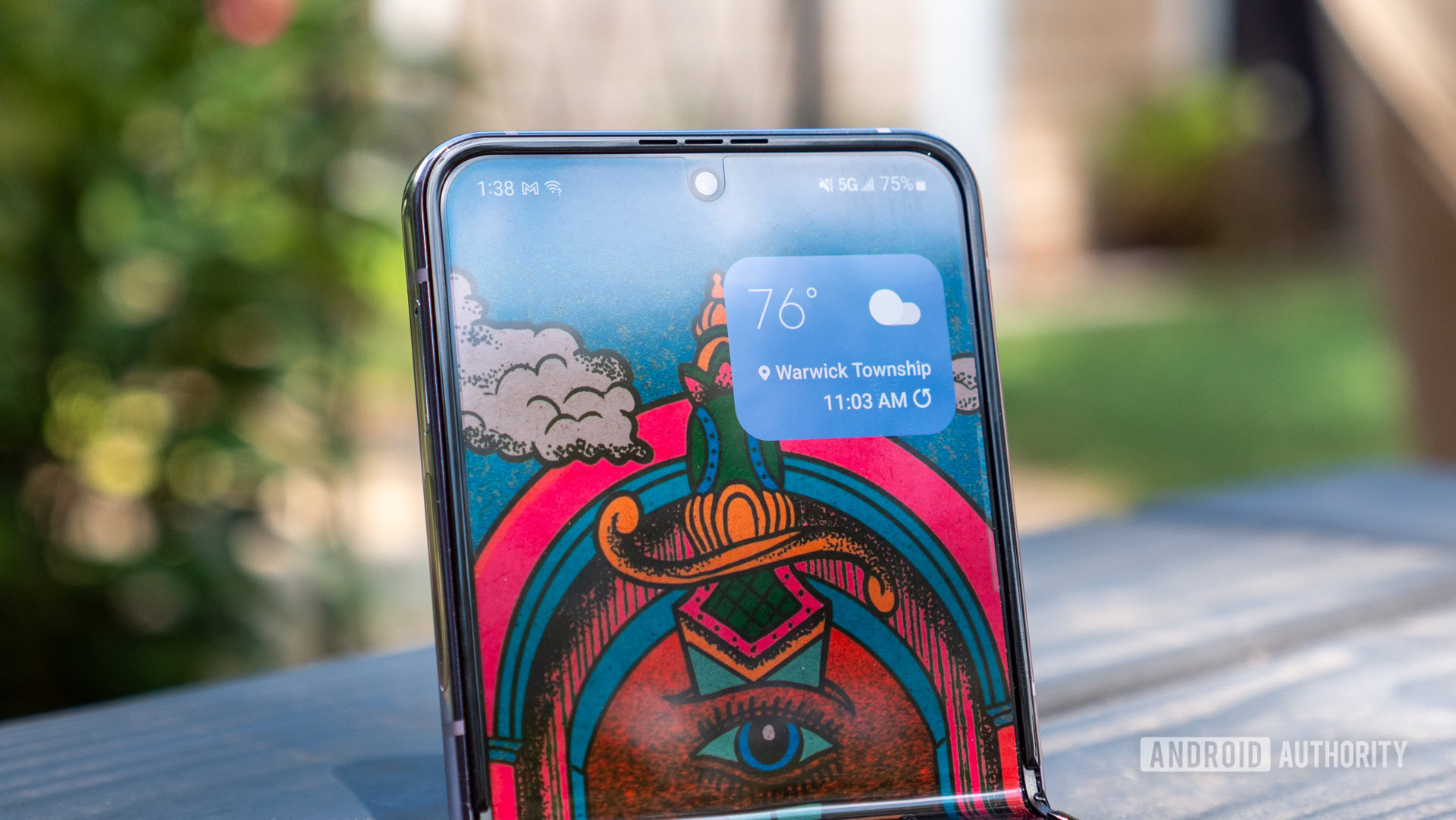
- Biometrics: The Galaxy Z Flip 4 sports a capacitive fingerprint scanner on its right edge, just like its predecessor. While most flagships have moved to an in-display scanner, Samsung’s side-mounted option is excellent, and I never had any issues with it identifying my touch. Some might find the placement difficult to reach, but it’s easy enough with your right thumb when the phone is open to any position.
- Audio: Like many flagships, the Galaxy Z Flip 4 packs a stereo speaker setup. The speakers are tuned by AKG, and they combine a single bottom-firing speaker with the earpiece for good results. I didn’t notice any vocal distortion until I turned the volume all the way up.
- Connectivity: Samsung’s clamshell offers almost all of the latest connectivity standards, including dual-SIM in the form of a nano-SIM slot and optional eSIM. It also carries Wi-Fi 6 and Bluetooth 5.2, which means it should have no problem staying future-proof for a while, though it doesn’t support Wi-Fi 6E. You’ll also find NFC support — a must for Samsung Pay — and ultra-wideband (UWB) for use with Galaxy SmartTags and other niche use cases.
- 5G: The Samsung Galaxy Z Flip 4 comes equipped with a full range of 5G coverage. It supports sub-6GHz bands and mmWave options in the US, though the latter will only make a big difference if you’re in specific hotspots in major cities, and are signed up to a compatible carrier.
Samsung Galaxy Z Flip 4 specs
| Samsung Galaxy Z Flip 4 | |
|---|---|
Displays | Exterior: - 1.9-inch Super AMOLED - 512 x 260 - Gorilla Glass Victus Plus Interior: - 6.7-inch Super AMOLED - 120Hz refresh rate - 2,640 x 1,080 |
Processor | Qualcomm Snapdragon 8 Plus Gen 1 |
RAM | 8GB |
Storage | 128, 256, or 512GB UFS 3.1 No expandable storage |
Power | 3,700mAh battery 25W Super Fast Charging Fast Wireless Charging 2.0 Wireless PowerShare No charger in box |
Cameras | Exterior: - 12MP wide, 1.8μm, OIS, Dual Pixel AF, ƒ/1.8 - 12MP ultrawide, 1.12μm, ƒ/2.2 Internal: - 10MP, 1.22μm, ƒ/2.4 |
Audio | Stereo speakers Dolby Atmos support No 3.5mm headphone port |
SIM | Single nano-SIM tray eSIM support |
Biometrics | Side-mounted capacitive fingerprint sensor |
Software | Android 12 One UI 4.1 |
Dimensions and weight | Folded dimensions: - 84.9 x 71.9 x 17.1mm (measured at hinge) Unfolded dimensions: - 165.2 x 71.9 x 6.9mm Weight: - 187g IPX8 water resistance |
Colors | Global: Bora Purple, Graphite, Pink Gold, Blue Bespoke Edition: - Front/back: Yellow, White, Navy, Khaki, Red - Frame: Silver, Black, Gold |
Value and competition


In a world where many brands are raising their prices, the Samsung Galaxy Z Flip 4 mercifully stays put. It still starts at $999 for the 128GB version, which makes it the relatively affordable clamshell foldable to beat. Just shy of $1,000 is still expensive for any phone, but the unique form factor will be worth a lot to buyers looking for something a bit different. The dual cameras and small battery might not compare well across the board, but the Galaxy Z Flip 4 retains a “fun factor” that has yet to diminish across four generations of Flip phones.
Samsung’s clamshell competition remains limited, at least in the United States. Right now, Motorola’s Razr Plus ($699.99 at Amazon) is the Galaxy Z Flip 4’s only practical foe, but it’s a worthy competitor. Motorola beat Samsung to the punch with a larger cover screen and even managed to work dust resistance into its latest Razr. While Samsung has the advantage when it comes to hardware — it has a sturdier hinge and more durable frame — it’s easier to grab any app and go on the Razr Plus.
The HUAWEI P50 Pocket is expensive, lacks Google services, and is highly limited in terms of availability. However, OPPO’s new Find N2 Flip ($1029 at Giztop) might be the best outside competition for the Galaxy Z Flip 4. It dwarfs Samsung’s external display, and OPPO has found a way to eliminate the much-maligned display crease. The Find N2 Flip is also set to make its way to European markets, putting a little extra heat on Samsung.
In fact, the best folding competition is coming from inside the house: the brand-new Galaxy Z Flip 5 ($999.99 at Samsung). It offers Samsung’s largest update in years, closing the gap between the hinge and adopting the Flex Window mentioned above. The Galaxy Z Flip 5 doesn’t reinvent its cameras, nor does it massage away the display crease, but the ability to comfortably run apps and in-depth widgets on the cover screen is a major upgrade. Of course, the trade-off is that Samsung’s larger cover display chugs more power from the same 3,700mAh battery, resulting in slightly worse returns. Where you could probably have held onto your Samsung Galaxy Z Flip 3 while waiting for the Galaxy Z Flip 4, it’s probably worth jumping to the Flex Window this time around.
Samsung’s own Galaxy Z Fold 5 ($1799.99 at Samsung) is another worthy foe. The book-style foldable grabs a few of the same internal upgrades as the Galaxy Z Flip 5, like the Snapdragon 8 Gen 2 for Galaxy chip, and keeps the same improved camera setup as the Galaxy Z Fold 4. In fact, it packs nearly the same tried-and-tested setup you’ll find on the smaller Galaxy S23 and Galaxy S23 Plus models, with a 50MP primary sensor backed by 10MP telephoto and 12MP ultrawide lenses. The premium foldable opens into a larger 7.6-inch display, which is also where you’ll find an under-display selfie camera (though it still needs some work). Perhaps the biggest change is that the Galaxy Z Fold line now runs tablet-inspired software based on Android 12L, which puts a taskbar at your fingers for easy access and split-screen control.
Google is now a player in the foldable game, too. The Google Pixel Fold ($1799 at Amazon) takes a similar approach to the Galaxy Z Fold 4, with a book-like 7.6-inch foldable display, a 5.8-inch outer display, and the in-house Tensor SoC at its heart. It’s worth noting that while pre-orders are now live, the Pixel Fold will only ship in June, while availability is limited compared to Samsung’s folders.
Sticking in the Samsung wheelhouse, the Galaxy S23 ($799 at Amazon) and Galaxy S23 Plus ($999.99 at Samsung) are fitting alternatives. The Flip shares a charging setup with the smaller S23, though it has the smallest battery of the bunch. No matter which way you go, you’ll get a largely similar software experience save for the Cover Screen and Flex mode functionality. As mentioned above, both Galaxy S23 devices pack more complete camera arrays than the small foldable, as well as support for Expert RAW, if you’re into that.
If you’re coming at the Galaxy Z Flip 4 from the perspective of wanting a small device that fits in your pocket, the ASUS Zenfone 10 ($699.99 at Amazon) might be worth a look. It’s the closest we’re likely to come to a small premium flagship (that runs Android), with its 5.9-inch display and premium Gorilla Glass Victus construction. The pocket-friendly powerhouse also packs a pair of rear cameras: a 50MP primary shooter and a 13MP ultrawide for good measure. They’re capable of up to 8K recording at 24fps, or 4K that reaches up to 120fps. Oh, and the latest Zenfone still has a headphone jack.
Venturing outside the Android bubble, the Galaxy Z Flip 4’s iOS comparisons are trickier. The iPhone 14 ($604 at Amazon) makes sense if you want something small and comfortable to carry. It offers a 6.1-inch display, but it’s backed by premium flagship internals. The dual cameras, both 12MP shooters, are up there with the best. However, if you want something closer in price to the Flip, it has to be the iPhone 14 Pro ($799.99 at Amazon). Apple’s flagship picks up the biggest camera upgrade in years — a 48MP main shooter — and a Dynamic Island for notification management, along with optimization that stretches the power for hours that the clamshell foldable can only dream of.
Samsung Galaxy Z Flip 4 review: The verdict
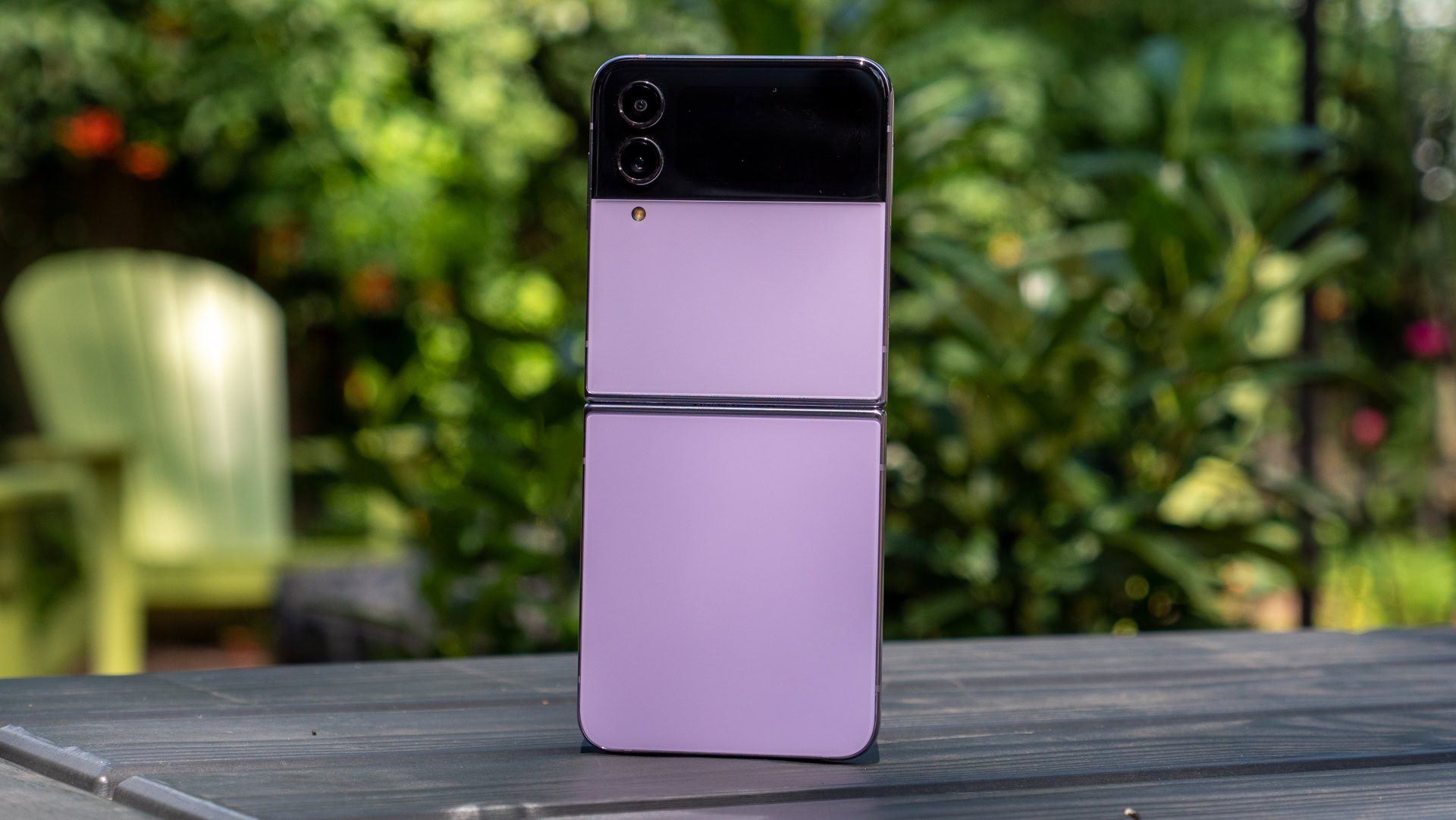
Samsung’s latest clamshell foldable doesn’t bring too many new pearls to the table, but it doesn’t have to. Instead, it applies a new sheen to an already excellent device, with subtle refinements to the design, internals, and cameras. Samsung has been saying that foldables are the future for a while now, and with a product this polished, it might finally be true.
After living in its siblings' spotlight, Samsung's clamshell is finally all grown up — if you've been waiting to try a foldable phone, the Galaxy Z Flip 4 is the easiest one to pick.
Although the Galaxy Z Flip 4 isn’t a reinvention from its previous generation, it’s highly refined — crease aside — and finally overcomes the most extreme of battery woes. It’s further buoyed by the clever Cover Screen functionality and one of the best update commitments in the business. Maybe Al Pacino really was onto something in that locker room speech because small changes have gone a long way to make the most popular foldable on the market even better.
With limited global competition into early 2023, Samsung easily remains on top of foldable mountain. The premium Galaxy Z Fold 4 might tempt power users, but most buyers can keep their attention here. Add a good trade-in deal to the mix via Samsung’s online offers, and it’s even harder to say no. Now, the only question is whether you should grab the Galaxy Z Flip 4 on a discount or splurge on the improved Galaxy Z Flip 5.
Top Samsung Galaxy Z Flip 4 questions and answers
The Samsung Galaxy Z Flip 4’s Ultra Thin Glass is rated for up to 200,000 folds, while the exterior is covered in Gorilla Glass Victus Plus with an Armor Aluminum frame. For a foldable phone, it’s about as durable as it gets, though it will be more prone to screen damage than a regular slab phone, and the hinge could be damaged by dust.
The Samsung Galaxy Z Flip 4 has an IPX8 rating for protection against immersion in water, though it is not dust-proofed.
Yes, the Galaxy Z Flip 4 has a visible crease, and it’s still as noticeable as it was on the Galaxy Z Flip 3.
Yes, the Samsung Galaxy Z Flip 4 supports wireless charging though it tops out at 10W.
No, the Galaxy Z Flip 4 does not have a headphone jack.
No, you do not get a charger bundled with the Samsung Galaxy Z Flip 4.